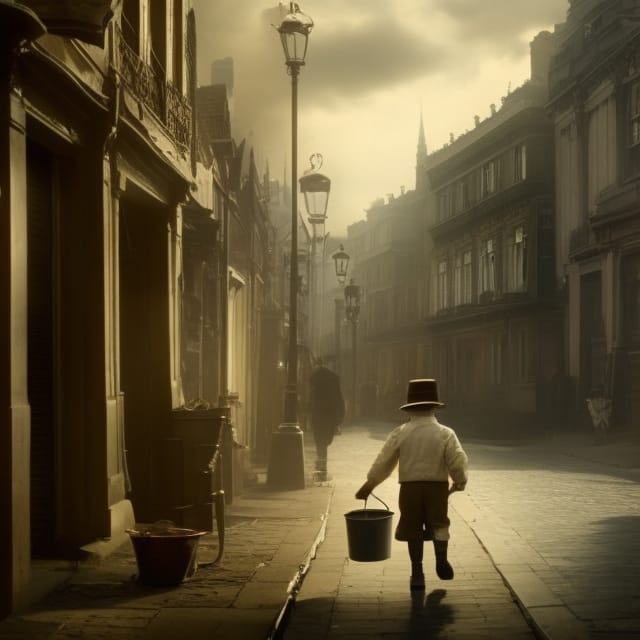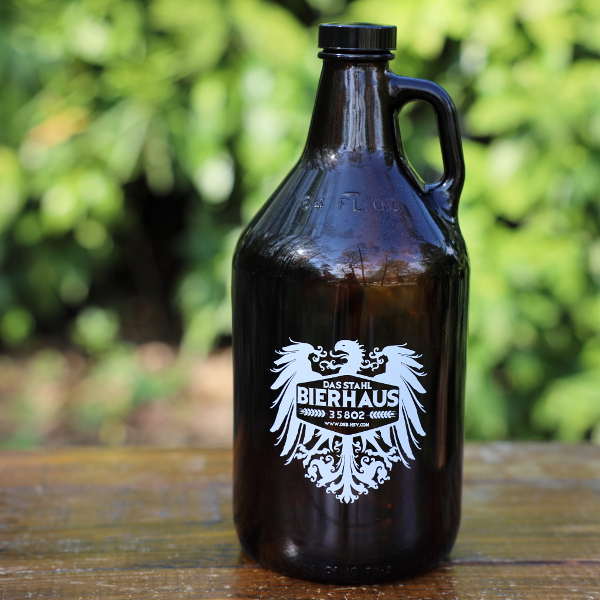What is a Craft Beer growler?
Craft Beer Growlers
When you find the craft beer of your dreams, there’s no better way to take it home with you than a growler. But what is a growler? A growler is a jug used to transport draft beer, often made of glass, ceramic, or stainless steel. It is typically filled straight from the tap and sealed with a cap to take home and enjoy. Growlers come in a variety of sizes, but 64 oz. is a common size.
At Das Stahl Bierhaus, we fill growlers with up to 128 oz. of any beer from our draft menu. Although, we recommend sticking to 64 oz. or less for the best quality and value. Keep reading to find out why.
Here, we dive into the history of the growler, how long a growler will keep your beer tap-fresh, the best growler size for beer storage and value, and how to clean your growler.
The History of the Growler
The issue of how to turn pub beer into home beer has long been an issue. As early as the late 1800s, people used several different vessels to transport beer home from the pub: glass jugs, tin pails, pitchers, etc. The most popular option was a galvanized pail holding roughly two quarts of beer.
While these were creative solutions, they weren’t effective. As a case in point, the name “growler” purportedly comes from the fizzle of carbonation escaping the beer as it sloshed around in the container on the walk home — not exactly the sound one wants to hear.
Bucket Boys
Growlers survived well into the 20th century. Leading up to WWII, the tradition was to have children transport craft beer to industrial workers around lunchtime or to their parents around dinnertime.

To do so, they would use covered buckets — a practice known as “rushing the growler.” They were a familiar sight in many American cities, ferrying beer from pubs to businesses and houses, trying to keep the liquid still as they walked.
These Bucket Boys, or “Kesseljunges” as the German-speaking population called them in Milwaukee, came under attack during the lead-up to Prohibition. At this time, lawmakers began lashing out at all alcohol-related service providers in an attempt to influence the public against drinking.
By the time the 18th Amendment passed, which ratified the prohibition of alcohol sales and consumption, growlers were completely outlawed in many states.
The Near-Death of the Growler
Prohibition came and went, but the growler took much longer to fade away.
The tin-pail growler lasted into the 1950s when other “technologies” like waxed-cardboard containers emerged to take its place. These resembled Chinese takeout soup containers in the shape of a milk jug; these were preferred to tin because they were disposable and cheap.
When plastic containers became more popular in the 1960s, bars began selling pre-packaged plastic containers full of beer after hours. Bargoers could take these containers home without needing to fill a growler from the tap.
With the acceptance of this practice, there was no longer a need for the containers that had been in use in varying forms for the past 70+ years. Over the decade, the growler nearly disappeared from the beer drinker lexicon.
The (Re)birth of the Growler
In 1989, a microbrewery owner named Charlie Otto faced a conundrum.
He wanted to offer draft beer to his customers to take home, but Otto Brothers Brewery was a draft-only microbrewery and could not legally bottle beer. So he needed a solution to allow his customers to transport beer without it going flat and without violating the law.
Luckily, Charlie’s father remembered a time when customers used growlers to transport beer home. Charlie loved the concept. Seizing the idea, he used a silk screen to print the brewery’s logo on half-gallon glass jugs.
Today’s craft beer growlers are similar in design to these early glass jugs but with some modern improvements.
How Long will Beer Stay Fresh in a Growler?
When it comes to craft beer, you’re getting fresh beer straight out of the tap. While that’s perfect when you’re drinking it on-site, it poses a certain set of restrictions when you’re transporting that beer home in a growler.
First, there’s the issue of spoilage. Craft beer Growlers are typically made from brown glass, which prevents sunlight and (specifically) UV light from infiltrating the beer inside. UV light interacts with the molecules in beer to degrade the beverage quality.
Then there’s the issue of oxygen. Even in small quantities, oxygen can rapidly spoil your craft beer and jeopardize the stability of its flavor. Modern growler caps are designed to prevent oxygen infiltration as much as possible.
However, neither the brown glass of the growler nor the tight seal of its cap is a total solution to the problem. Light and oxygen both find their way into growlers and begin to degrade the beer.
In addition to spoilage, there’s the issue of flatness. This happens when the carbonation inside beer escapes, leaving a non-bubbly and thoroughly inferior beverage in its wake.
While craft beer growler caps are designed to maintain pressure inside the container, which keeps carbonation intact, they aren’t a perfect solution. Carbonation will continuously leak from a growler, particularly when it’s not being refrigerated.
For best results, drink your growler beer within two days of filling it. Keep it refrigerated and out of direct sunlight, and it’s recommended that you finish it the same day you open it.

Also note, that we don’t recommend putting nitrogen (N2) beers in growlers since N2 beers go flat faster than CO2-carbonated beers. However, we’ll do this for you if you want.
Whats the Best Sized Growler for Beer?
It’s simple: We don’t recommend growlers larger than 64 oz. Both 64-oz. and 32-oz. growlers are ideal sizes if you’re taking beer home.
Why? Because when you go larger than 64 oz. (for example, a 128-oz. growler), you’re better off buying a keg. A keg will offer better freshness and a actually cost you less per floz. Freshness and cost aside draft beer at home is the best of both worlds.
How to Clean Your Growler
To clean your growler:
- Rinse it with hot water as soon as you’re done using it, preferably several times.
- Drop a bit of dish soap inside and fill it a quarter of the way with hot water.
- Cap it and shake it vigorously.
- Rinse and shake with hot water (no dish soap) until the aroma of soap and/or beer is completely gone.
- Let it dry upside down.
TLDR
In conclusion, craft beer growlers are a convenient and eco-friendly way to enjoy draft beer at home. From their humble beginnings as bucket boys with galvanized pails to the modern glass jugs we know today, growlers have come a long way in terms of functionality and freshness.
By following best practices for filling, storing, and cleaning growlers, you can ensure that your beer will stay fresh and delicious for as long as possible. With a variety of sizes and materials to choose from, there is a growler option out there for every beer lover.
